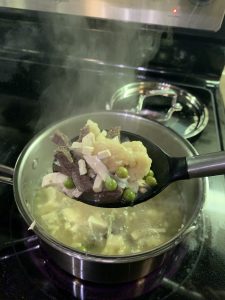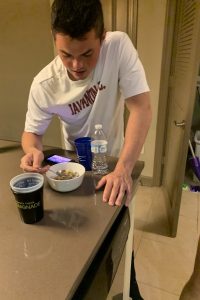As I mentioned on the first day of class, a dish that holds deep sentimental meaning to me is sujebi – a hand-pulled Korean “noodle” dish. This dish not only represents my Korean heritage, but the strong women in my family that I have the pleasure of looking up to. My grandma and mother are the backbone of my family and a large part of the reason why I am here today. As a first-generation immigrant family on both sides, my grandmother and mother were both very courageous to come to the United States to live a better life. My grandmother supported my grandfather and her son (aka my father), and my mother supported herself as a young college student. It was not until later on in her life that my mother would also be supporting my father before settling down to start a family together in a new country they would call home. I love this dish not only because it is delicious, but because it is just as fun to make as it is to eat. A normal activity at my grandmother’s house would be to sit down on the kitchen floor and take turns kneading a large bowl of homemade dough until it was sticky enough to pull apart and put in the boiling pot of broth. There was something magical about the way something so delicious could derive from our hands. Made with lots of love, energy, and a grandmother’s touch, the bite-size hand-pulled noodles were always a delight to eat.
My relationship with my mother is always an interesting story to tell, because of our cultural and language barriers in the way during my upbringing. Because she was my mother whom I lived with every day, unlike my grandmother, our daily lives together involved many arguments over miscommunication and misunderstanding. Our best form of communication ended up being food, which quickly served as a medium that we both used to show our love and affection for each other. Coming from a different country, my mother was not familiar enough with Western food culture to make me steak, chicken, or pasta dishes for dinner after school. My mother knew how much I loved noodles and pasta, so sujebi was the Korean-alternative dish that she knew I would enjoy to eat and could even help her in the kitchen to make. Cooking was the only fail-proof time that did not involve any fighting, and to this day, is a very important activity to me that I now love to do.
Sujebi requires some effort in preparing the dough but uses very minimal ingredients. Therefore, sujebi to me is also the embodiment for enjoying the little things in life. Beyond the precious time I got to spend with my mother not arguing, she did not have to buy expensive ingredients or prepare a lavish meal to make me happy; the meal was affordable for a new family on a tight budget. Especially on days when we could not necessarily afford any protein or immediately go grocery shopping, an easy mixture of flour, water, and salt could be used to make the dough. The best part about this dish is that you can. As a result, sujebi was also the perfect dish for a picky-eater, like myself, because my mother could put in all of my favorite vegetables and still make it taste very good. Sometimes the soup stock would be beef, vegetables, or seafood, depending on the day. It never fails to come together. I quoted noodle earlier in the first paragraph of my introduction for sujebi because the noodle itself is not in the standard form of long strand. Rather, it is a bit-size flat lump of dough that requires no slurping and chewy to eat! I personally relate the consistency of it as al-dente, which is one of the reasons why I like this dish.
Though I am not a fan of using Wikipedia, it was actually very difficult to find a reliable historical that wrote about sujebi. According to the page, sujebi derived in the Gorveo period from 935 to 1392. There are many noodle-variations amongst different Asian cultures, so I was really intrigued to read that this atypical shape of noodle emerged very early in its time. While the hand-pulled noodle shape is specific to sujebi, different geographical locations call sujebi by different names around South and North Korea. In North Korea, the dish – milgaru ddeudeo guk – translates to “wheat flour, hand-torn, soup.” Other name variations for sujebi around South Korea by itself includes ddeudegi or ddedeokguk, ddeoneonjuk or ddiyeonjuk, sujibi, miljebi, or milkkarijang guk, dabureong juk or beongeuraegi. (https://en.wikipedia.org/wiki/Sujebi) Personally translating this myself, the name variations all agree that it is a soup-based dish, a type of flour-based noodle that is hand-pulled or torn.
There is no historical fact on this site, but my personal prediction is that the hand-pulled noodle was invented for convenience. If someone could not afford the technology, time, and tools to make long string-like noodles, the next best alternative would be to use our own tools: hands. Wikipedia did say that sujebi first made its appearances in specific celebratory occasions, making it a special dish. However, this luxury did not last long as it quickly became a staple food for many commoners. The ingredients are not costly, and can be made from scraps like myself! The recipe below is my own mother’s, which I have used in the very picture I attached of the dish. However, since I did not have all the vegetables she recommended for the broth, I just used beef, tofu, potatoes, peas, and onions! I am very proud of this as it is the first time I made sujebi by myself without having my grandmother or mother to help me. I was craving a taste of home and feeling quite homesick during my first week in the new apartment after I moved to Atlanta. I even shared with my roommate and her friend and they both seemed enjoyed it as well.
My Mother’s Sujebi Recipe:
Hand-Pulled Noodle Dough:
- 3 Cups of Flour
- 2 Teaspoons of Salt
- 1.25 Cup of Warm Water
Broth:
- Pot of Boiling Water
- 3 Large Dried Anchovy
- 1 Cup Fresh Cut Green Onion (Sliced)
- 2 Potatoes (Cubed)
- 1/2 Cup Zucchini (Sliced)
- 1 Egg (optional)
- Cubed Flank Steak (optional)
- Seafood (optional)
For the dough: Combine the flour, salt, and warm water in a large mixing bowl and stir until it forms a dough-like consistency. Set aside to sit until broth is ready (~10-15 minutes).
For the broth: Bring a pot of water to a boil and add dried anchovies for 5 minutes. Take out anchovies and add the green onions, potatoes, and zucchini to boil for 10 minutes. While vegetables are cooking, take the dough and pull apart a little piece about 0.5 inch. Use thumbs to press into a flat shape and add into boiling pot. Repeat this step until all of the dough is used. You know it is done cooking when the dough expands and rises to the top (kind of like tortellini!). Optional: add an egg to broth and mix to scramble for extra flavor. Serving size: 2-3 people.



Overall, this dish will and always be so special to me even if I do not eat it at home, because I know the dish must always be handmade. I know it would be handmade because asian markets do not even sell pre-made versions of this dough to use for sujebi. After all, the dish would not be called sujebi without its hand-torn noodle dough bits. Whether I am home, at a restaurant, or by myself in my apartment, I eat this dish with praise and thanks for the person who gave me their time, energy, and care in preparing it for me.

Hi, Naya, thanks for introducing us to the wonderful world of sujebi. I’m touched by the aspirational immigration stories of your grandmother and mother. The experience of making sujebi together as a family sounds particularly interesting, as you would take turns kneading the dough first. I’m glad food becomes the means of communication between you and your mom. Your connection to sujebi is also quite special, which gives you another outlook on life. Thanks for the dutiful research on the dish as well. I’ve certainly learned a lot. Last but not least, lovely photos!